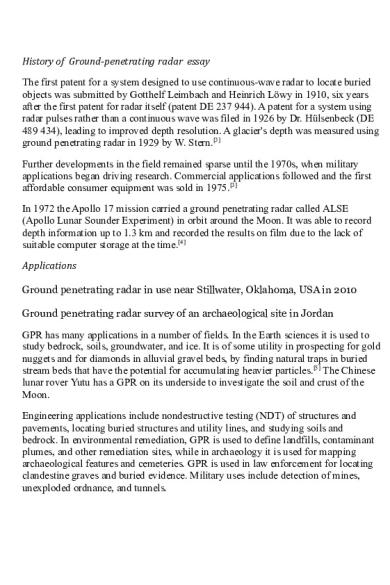History of Ground-penetrating radar PDF

| Title | History of Ground-penetrating radar |
|---|---|
| Course | Three Dimensional Advanced Design Practice |
| Institution | Northumbria University |
| Pages | 2 |
| File Size | 86.4 KB |
| File Type | |
| Total Downloads | 87 |
| Total Views | 127 |
Summary
Archaeology Ground penetrating radar survey...
Description
History of Ground-penetrating radar essay The first patent for a system designed to use continuous-wave radar to locate buried objects was submitted by Gotthelf Leimbach and Heinrich Löwy in 1910, six years after the first patent for radar itself (patent DE 237 944). A patent for a system using radar pulses rather than a continuous wave was filed in 1926 by Dr. Hülsenbeck (DE 489 434), leading to improved depth resolution. A glacier's depth was measured using ground penetrating radar in 1929 by W. Stern.[3] Further developments in the field remained sparse until the 1970s, when military applications began driving research. Commercial applications followed and the first affordable consumer equipment was sold in 1975.[3] In 1972 the Apollo 17 mission carried a ground penetrating radar called ALSE (Apollo Lunar Sounder Experiment) in orbit around the Moon. It was able to record depth information up to 1.3 km and recorded the results on film due to the lack of suitable computer storage at the time.[4] Applications Ground penetrating radar in use near Stillwater, Oklahoma, USA in 2010 Ground penetrating radar survey of an archaeological site in Jordan GPR has many applications in a number of fields. In the Earth sciences it is used to study bedrock, soils, groundwater, and ice. It is of some utility in prospecting for gold nuggets and for diamonds in alluvial gravel beds, by finding natural traps in buried stream beds that have the potential for accumulating heavier particles.[5] The Chinese lunar rover Yutu has a GPR on its underside to investigate the soil and crust of the Moon. Engineering applications include nondestructive testing (NDT) of structures and pavements, locating buried structures and utility lines, and studying soils and bedrock. In environmental remediation, GPR is used to define landfills, contaminant plumes, and other remediation sites, while in archaeology it is used for mapping archaeological features and cemeteries. GPR is used in law enforcement for locating clandestine graves and buried evidence. Military uses include detection of mines, unexploded ordnance, and tunnels.
Borehole radars utilizing GPR are used to map the structures from a borehole in underground mining applications. Modern directional borehole radar systems are able to produce three-dimensional images from measurements in a single borehole.[6] One of the other main applications for ground-penetrating radars is for locating underground utilities. Standard electromagnetic induction utility locating tools require utilities to be conductive. These tools are ineffective for locating plastic conduits or concrete storm and sanitary sewers. Since GPR detects variations in dielectric properties in the subsurface, it can be highly effective for locating nonconductive utilities. GPR was often used on the Channel 4 television programme Time Team which used the technology to determine a suitable area for examination by means of excavations. In 1992 GPR was used to recover £150,000 in cash that kidnapper Michael Sams received as a ransom for an estate agent he had kidnapped after Sams buried the money in a field.[...
Similar Free PDFs

GELOMBANG RADAR
- 12 Pages

radar ARTS
- 11 Pages

Surface-penetrating radar
- 19 Pages

Radar tutorial IMP
- 18 Pages

Sekilas Tentang Radar Cuaca.pdf
- 76 Pages

24-radar - Lecture notes 1,2,3
- 11 Pages

Ficha Tecnica Radar-clima-plus
- 2 Pages

The History Of Probation
- 4 Pages

Brief history of Psychology
- 4 Pages

History of swimming timeline
- 1 Pages

History of Siwes
- 44 Pages
Popular Institutions
- Tinajero National High School - Annex
- Politeknik Caltex Riau
- Yokohama City University
- SGT University
- University of Al-Qadisiyah
- Divine Word College of Vigan
- Techniek College Rotterdam
- Universidade de Santiago
- Universiti Teknologi MARA Cawangan Johor Kampus Pasir Gudang
- Poltekkes Kemenkes Yogyakarta
- Baguio City National High School
- Colegio san marcos
- preparatoria uno
- Centro de Bachillerato Tecnológico Industrial y de Servicios No. 107
- Dalian Maritime University
- Quang Trung Secondary School
- Colegio Tecnológico en Informática
- Corporación Regional de Educación Superior
- Grupo CEDVA
- Dar Al Uloom University
- Centro de Estudios Preuniversitarios de la Universidad Nacional de Ingeniería
- 上智大学
- Aakash International School, Nuna Majara
- San Felipe Neri Catholic School
- Kang Chiao International School - New Taipei City
- Misamis Occidental National High School
- Institución Educativa Escuela Normal Juan Ladrilleros
- Kolehiyo ng Pantukan
- Batanes State College
- Instituto Continental
- Sekolah Menengah Kejuruan Kesehatan Kaltara (Tarakan)
- Colegio de La Inmaculada Concepcion - Cebu




